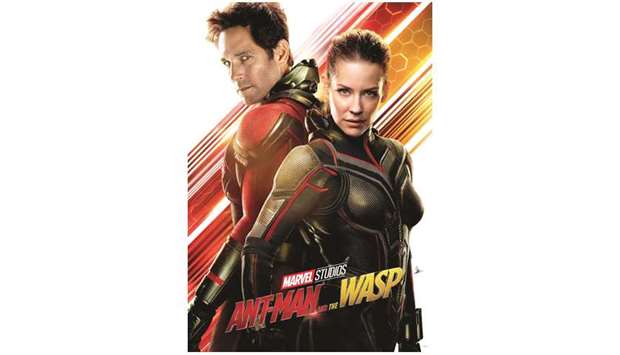The unlimited breadsticks approach of the Marvel Cinematic Universe ensures that we remain full of carbs, all year, as each franchise rolls out another metaphorical Olive Garden. Some of the movies offer veritable superhero conventions, most recently the ensemble blowout Avengers: Infinity War, which managed to make $2.3 billion worldwide without any interesting action sequences, mainly on the strength of that ridiculously dire cliff hanger ending.
But other Marvel breadstick platters are a little lighter, a little less apocalyptically threatening, such as Ant-Man (2015) and the new Ant-Man and the Wasp. I’m fond of these movies. They’re more my speed. It wouldn’t be Marvel without an action climax twice as long as it is compelling, but returning director Peyton Reed is a nimble, clever company man, not a miracle worker.
The sheer volume of Marvel movies has a way of wiping your memory clean, so that you forget how pretty good many of these have been previously. Marvel studio head Kevin Feige has figured out how to let each franchise take its own shape and establish its own tones within a prescribed scale. (Patty Jenkins and Wonder Woman accepted the DC Comics strategy, by contrast, seems to be, as long as we hire the wrong directors and take all the fun out of it, we’ll be fine.)
The tone of Ant-Man and the Wasp is in the title. Nobody’s threatening a war without end here. The screenplay continues the story of genial ex-con Scott Lang (Paul Rudd, also one of the five credited writers), who stumbled onto the subatomic-particle spandex invented by former S.H.I.E.L.D. agent Hank Pym (Michael Douglas). For 30 long years Hank’s wife and partner Janet (Michelle Pfeiffer) has been lost in the quantum realm, which resembles a polyp-ridden aquarium, daughter Hope (Evangeline Lilly) yearns for her, as does Hank. They have the technology, the wasp getup originally worn by Janet. Now it’s Hope’s turn to try it on and, like Lang/Ant-Man, radically shift her size and dazzle her enemies with the click of a remote and a kick to the head.
Hank builds a tunnel for quantum realm spousal extraction, and Scott/Ant-Man’s the man for the plan. Meantime, though, he has child care responsibilities. Abby Ryder Fortson returns as young Cassie, Judy Greer is back as her mom, Scott’s ex - Bobby Cannavale again provides unexpected sweetness as Cassie’s stepdad. Everybody gets along, which is nice to see in a movie like this.
Scott has three days to go on a house arrest stint for world saving activities depicted, briefly, in Captain America: Civil War. But the Pymfolk need him, stat. Many adversaries covet the schmaltzy ant and wasp suit technology for their own interests. Walton Goggins slimes around as a ‘quantum energy’ dealer, in bed with bad people from other countries, Hannah John-Kamen (Black Mirror) is the pale, smoky-eyed Ghost, who phases her way through solid matter and searches for a cure to relieve her constant pain. Laurence Fishburne plays Hank’s former S.H.I.E.L.D cohort and rival. Scott’s fellow security expert business partners pop in for comic relief. But that’s not really accurate, for a change. Director Reed looks for the buoyant details and witty asides in most every scene. The script provides plenty. “Do you guys just put ‘quantum’ in front of everything?’ Scott says, interrupting another realm of scientific hooey. Rudd is such a friendly, likable presence. He sets this movie’s pace, while Lilly’s fiercely committed Hope/Wasp acts as the perfect counterweight. Rudd’s scenes with Lilly and with Fortson make the movie matter in human terms.
Visually here’s the crucial thing with Ant-Man and the Wasp, the sequel has upped the instances and exploits of the rapidly changing superheroes, and every time the movie cuts to a shot of the heroes’ miniaturised car, scooting around the streets of San Francisco, it’s good for a laugh. Similarly, the first time Hank’s secret laboratory gets shrunk down to a suitcase size, it’s an adroit visual gag. Scott can’t quite control whatever size he’s about to transform into, which makes his dilemma relatable to anyone who never really knows if hitting send will actually send something to someone.
The action finale follows the Marvel rule of leave ‘em overstuffed with breadsticks, yet somehow ready for more. The byplay, more than the mayhem, makes the Ant-Man outings distinctive. One late scene between Rudd and Randall Park (as continually hoodwinked agent Jimmy Woo) exists entirely to let two masters of droll hesitation do what they do best. Does it “forward the plot”? Does it kill you with digital seizures we’ve all experienced before? No, and no. It’s just funny.– Chicago Tribune/TNS

.
